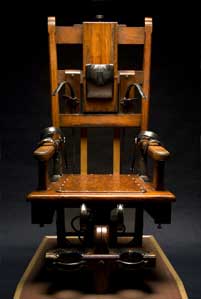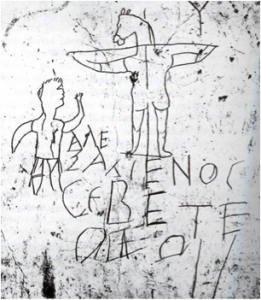In an article entitled “FactChecker: The Cross an Electric Chair?” found Glen T. Stanton writes:
Have you ever heard a Christian writer, teacher, or pastor say something like the following?
“When Jesus told those who would follow him that they must ‘take up his cross daily’ this was like telling people today to take up their electric chairs and follow him.”
or
“For Christians to wear crosses around their necks is like us wearing a symbol of an electric chair.”
 The analogy between the cross and an electric chair is intended to show that, while the cross has become a common and even sentimental symbol of Christianity today, in Christ’s day it was a harsh symbol of execution. Like an electric chair is today.
The analogy between the cross and an electric chair is intended to show that, while the cross has become a common and even sentimental symbol of Christianity today, in Christ’s day it was a harsh symbol of execution. Like an electric chair is today.
It is an important truth that Christians of every age remember about the cross. But the electric chair analogy actually deludes the point.
This comparison between the cross and old sparky was first made by an important theologian of the 1960s: Lenny Bruce. In a series of articles he serialized in Playboy, later published in his 1967 posthumous book, How to Talk Dirty and Influence People, Bruce observed,
If Jesus had been killed twenty years ago, Catholic school children would be wearing little electric chairs around their necks instead of crosses.
Cue the laughter. But the truth is, an electric chair and a cross are similar in only one way: each is designed to kill criminals. Otherwise, they are nothing alike.
The electric chair was created by the Edison Company in the late 1800s as a means to execute a prisoner faster and more humanely. Typically, the process—leading up to, during, and following our executions today—is carefully scripted and implemented to ensure the criminal dies with some dignity and as little suffering as possible.
The cross was designed and used to execute criminals in the slowest, most painful, agonizing, and humiliating way possible, reserved only for slave, pirates, and traitors. Being such an unspeakably horrifying way to die, Roman citizens were not subjected to it. Anyone hanging on a cross was of no value whatsoever. They were a curse. When Paul wrote to the Galatians about the nature of Christ’s death, they knew exactly what he was talking about because they knew what the cross signified.
“Christ redeemed us from the curse of the law by becoming a curse for us, for it is written: ‘Cursed is everyone who is hung on a tree.'” (Gal. 3:13)
And the Corinthian Church understood what Paul meant when he declared:
“. . . but we preach Christ crucified: a stumbling block to Jews and foolishness to Gentiles . . .” (I Cor. 1:23)
It was indeed foolish and a stumbling block to those who heard the gospel to hear that one’s God ended up on a cross. It was absurd.
John Stott, in The Cross of Christ, quotes Cicero on how debased and unthinkable such a death was,
To bind a Roman citizen is a crime, to flog him is an abomination, to kill him is almost an act of murder: to crucify him is – What? There is no fitting word that can possibly describe so horrible a deed.
 The earliest known depiction of the crucifixion of Christ is a graffito scratched into stone just years after the Gospel was first preached in Rome. Seen here, it is a rough sketch of a crucified man, but with the head of donkey. A young man has arm raised in reverence or worship. The letters etched below read “Alexamenos worships his god.”
The earliest known depiction of the crucifixion of Christ is a graffito scratched into stone just years after the Gospel was first preached in Rome. Seen here, it is a rough sketch of a crucified man, but with the head of donkey. A young man has arm raised in reverence or worship. The letters etched below read “Alexamenos worships his god.”
It was a common statement of insult, portraying Christians as those who gave their lives in worship to an ass. The Octavius, a very early work of Christian apology answers the common accusation made against Christianity that,
The religion of the Christians is foolish, inasmuch as they worship a crucified man, and even the instrument itself of his punishment. They are said to worship the head of an ass . . .
Everett Ferguson, in his Backgrounds of Early Christianity, explains the thinking behind this taunting and wild accusation:
As repulsive as the [Alexamenos graffito] is to Christians now, it conveys strongly how contemptible the idea of a crucified Lord was to pagan thinking.
This very point was our artist’s belittlement of the young Christian, Alexamenos.
The following facts provide the worlds-apart contrast of the cross and the electric chair.
• Those conducting an electric chair execution don’t do it as sport, seeing how creatively and how long they can inflict pain, suffering, and humiliation. This was precisely what execution on a cross was about.
• People put to death in electric chairs are not forced to carry their own means of execution to the place they will die. The crucified were required to.
• Those walking their last steps to the electric chair are not taunted, spit upon, kicked, punched, and verbally demeaned. The crucified were.
• Those going to the electric chair are not brutally scourged to the point of substantial blood-loss as a lead-up to their electrocution. The crucified were.
• People going to the electric chairs are not stripped bare so their death is more humiliating. The crucified were.
• Those in the electric chair are protected from the mob-circus who would celebrate in their death. The crucifixion is designed precisely to expose the condemned to such people.
• People executed in electric chairs do not have their legs broken to finally bring death after days of suffering there. The crucified did.
• Those executed in electric chairs are not left on display for all to see as a statement to other criminals. The crucified were left that way for days after death.
• The electric chair dead are not left for the birds and wild animals to pick away at. The crucified were.
• Those killed by the electric chair are given at least a modest burial. The crucified were denied burial and what remained of their bodies was thrown away. (Joseph of Arimathea went to Pilate to get permission to have Jesus’ body for burial.)
Yes, it is important that we remind fellow believers that the Cross of our faith was a device of death, torment, and humiliation; a symbol of great offense. That is why the electric chair comparison just doesn’t work. Nor does the noose, the gas chamber, or the lethal syringe.
There is no parallel symbol to speak of what our Savior suffered and endured for each of us. And that is why the cross is the primary and universal symbol for our faith. It is a peerless and powerful reminder of the dramatic extent of Christ’s love. And it makes Christianity unique and powerful beyond compare.
